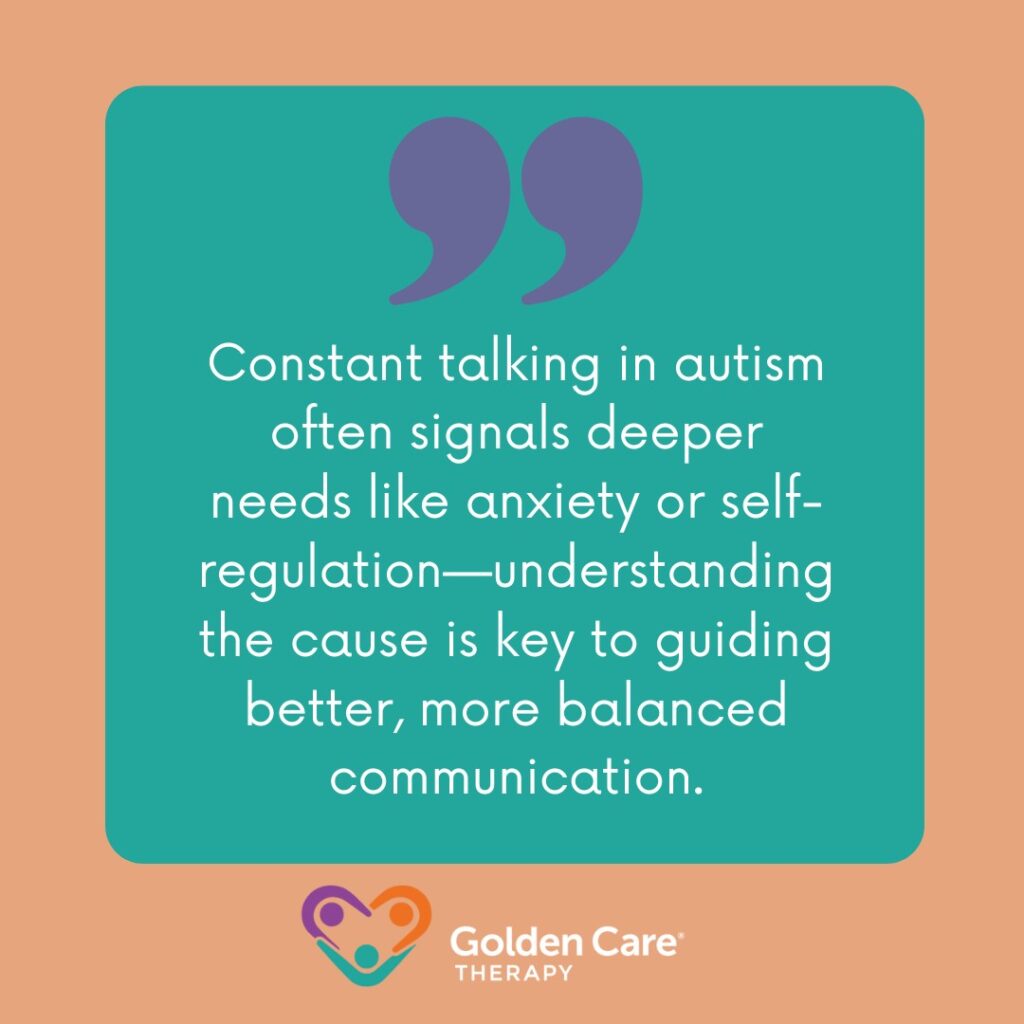Key Points:
- Constant talking in autism, often referred to as “perseverative speech,” is a common behavior that can stem from communication challenges, anxiety, or a need for self-regulation.
- Understanding the root causes of excessive talking can help caregivers and professionals develop effective strategies to support individuals with autism.
- Applied Behavior Analysis (ABA) therapy is a proven approach to address communication challenges and repetitive behaviors in autism.
Does your child with autism talk nonstop about trains, dinosaurs, or their favorite show? This behavior, known as constant talking, is common in autism and often serves a purpose. By understanding its causes—like communication challenges or self-regulation—you can create strategies to support your child effectively. Let’s break it down.

Autism Constant Talking: an Overview
Autism constant talking, often called perseverative speech, refers to excessive or repetitive talking about a specific topic. This behavior can include lengthy monologues, repeated phrases, or an intense focus on a particular subject.
It often stems from communication challenges, anxiety, or a need for self-regulation. For many individuals with autism, constant talking provides comfort, helps process emotions, or serves as a way to engage with their special interests. Understanding this behavior is key to supporting their unique communication needs effectively.
Causes of Excessive Talking in Autism
Excessive talking in autism, often referred to as perseverative speech, is rarely random. It typically stems from specific triggers or unmet needs. Understanding these causes can help caregivers and professionals develop effective strategies to support individuals with autism.
1. Difficulty with Social Communication
Many individuals with autism struggle with social communication, making it hard to engage in typical back-and-forth conversations. They may not pick up on social cues like body language or tone of voice, leading to one-sided conversations. This can result in constant talking as they rely on familiar topics or scripts to navigate interactions.
2. Sensory Overload and Self-Regulation
Talking can serve as a self-soothing mechanism during sensory overload. For example, a child might repeat phrases to block out overwhelming noises or environments. This repetitive speech helps them regulate their emotions and feel more in control.
3. Intense Focus on Special Interests
Individuals with autism often have deep passions for specific topics, such as trains, dinosaurs, or technology. Talking about these interests provides comfort, joy, and a sense of mastery, leading to excessive discussion.
4. Anxiety or Emotional Regulation
Repetitive speech can also be a response to anxiety or stress. It helps some individuals process their emotions, providing a sense of security and predictability in uncertain situations.

How to Address Constant Talking in Autism
Managing constant talking in autism requires a thoughtful approach that balances understanding the individual’s needs with practical strategies. Here are some effective ways to address this behavior:
1. Encourage Alternative Communication Methods
For individuals who rely on constant talking, introducing alternative ways to express themselves can be helpful. Visual aids, such as picture cards or communication boards, allow them to share their thoughts without relying solely on speech. Social stories, which use simple narratives, can also teach appropriate conversation skills, like taking turns or changing topics.
2. Set Clear and Consistent Boundaries
Establishing boundaries can help manage excessive talking without discouraging communication. Designate specific times for discussing favorite topics, and use tools like visual timers to signal when it’s time to transition. This provides structure while respecting their interests.
3. Provide Opportunities for Self-Regulation
Constant talking can sometimes be a coping mechanism for sensory overload or anxiety. Offering sensory tools, such as stress balls or noise-canceling headphones, can help individuals self-regulate. Calming activities like drawing or listening to music can also reduce the need for repetitive speech.
4. Seek Professional Support
If constant talking significantly impacts daily life, professional intervention may be necessary. Speech therapy can improve communication skills, while ABA therapy addresses underlying causes and teaches replacement behaviors. These therapies provide tailored strategies for long-term success.
The Role of ABA Therapy in Managing Autism Constant Talking
ABA therapy is a structured, evidence-based approach that focuses on improving specific behaviors, including communication challenges. Here’s how it can help with constant talking:
1. Identifying Triggers
ABA therapists work to understand the root causes of repetitive speech, whether it’s anxiety, sensory issues, or a need for self-expression.
2. Teaching Replacement Behaviors
ABA therapy helps individuals learn alternative ways to communicate and self-regulate, reducing reliance on constant talking.
3. Building Social Skills
Through targeted interventions, ABA therapy teaches individuals how to engage in balanced conversations and recognize social cues.
Practical Tips for Caregivers
Managing constant talking in autism requires patience, consistency, and a thoughtful approach. Here are some actionable tips to help caregivers support their loved ones effectively:
- Be Patient and Understanding: Acknowledge the individual’s need to talk and avoid dismissing their interests. Show empathy and validate their feelings, as this can help build trust and reduce frustration.
- Use Positive Reinforcement: Praise the individual when they engage in balanced conversations or follow set boundaries. Rewarding efforts to try new communication methods encourages positive behavior over time.
- Create a Structured Environment: Establish routines to provide predictability and security. Use visual schedules to help the individual understand daily activities and transitions, reducing anxiety and repetitive speech.
- Collaborate with Professionals: Work with therapists, teachers, and other caregivers to develop a consistent approach. Sharing strategies that work well at home ensures continuity in other settings, like school or therapy.

When to Seek Professional Help
While many strategies can be implemented at home, there are times when professional intervention is necessary. Consider seeking help if:
- The constant talking significantly interferes with daily functioning.
- The individual shows signs of distress or frustration.
- You’re unsure how to address the behavior effectively.
ABA therapy, in particular, can provide tailored support to address communication challenges and improve overall quality of life.
Discover How Golden Care Can Help
If your child’s autism constant talking is impacting their daily life, it may be time to explore professional support. At Golden Care, we specialize in providing personalized ABA therapy to help individuals with autism develop effective communication skills and reduce repetitive behaviors.
Our team of experienced ABA therapists in New York, Florida, Indiana, New Jersey, and Georgia are dedicated to creating individualized plans that address your child’s unique needs. Whether it’s managing excessive talking or building social skills, we’re here to help every step of the way.
Reach out today to schedule a consultation and take the first step toward a brighter future for your child.



